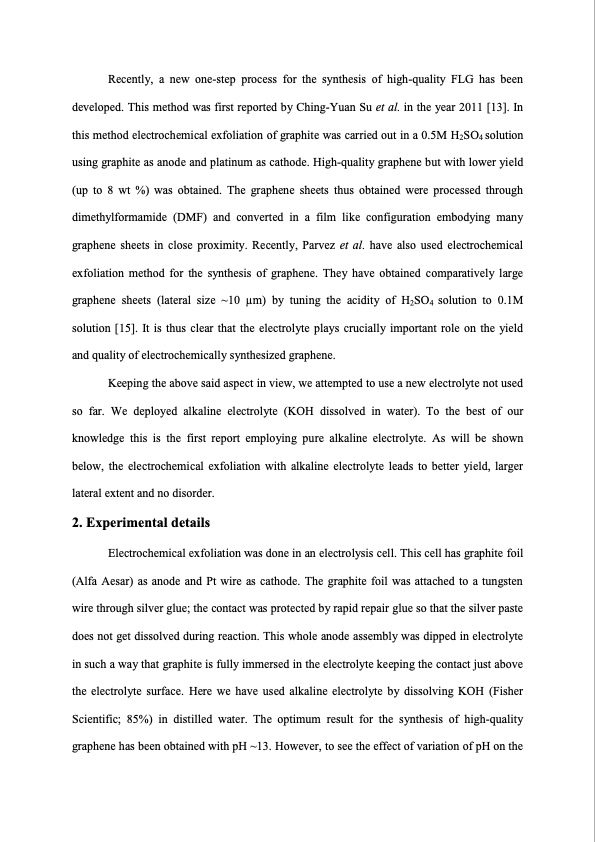
PDF Publication Title:
Text from PDF Page: 003
Recently, a new one-step process for the synthesis of high-quality FLG has been developed. This method was first reported by Ching-Yuan Su et al. in the year 2011 [13]. In this method electrochemical exfoliation of graphite was carried out in a 0.5M H2SO4 solution using graphite as anode and platinum as cathode. High-quality graphene but with lower yield (up to 8 wt %) was obtained. The graphene sheets thus obtained were processed through dimethylformamide (DMF) and converted in a film like configuration embodying many graphene sheets in close proximity. Recently, Parvez et al. have also used electrochemical exfoliation method for the synthesis of graphene. They have obtained comparatively large graphene sheets (lateral size ~10 μm) by tuning the acidity of H2SO4 solution to 0.1M solution [15]. It is thus clear that the electrolyte plays crucially important role on the yield and quality of electrochemically synthesized graphene. Keeping the above said aspect in view, we attempted to use a new electrolyte not used so far. We deployed alkaline electrolyte (KOH dissolved in water). To the best of our knowledge this is the first report employing pure alkaline electrolyte. As will be shown below, the electrochemical exfoliation with alkaline electrolyte leads to better yield, larger lateral extent and no disorder. 2. Experimental details Electrochemical exfoliation was done in an electrolysis cell. This cell has graphite foil (Alfa Aesar) as anode and Pt wire as cathode. The graphite foil was attached to a tungsten wire through silver glue; the contact was protected by rapid repair glue so that the silver paste does not get dissolved during reaction. This whole anode assembly was dipped in electrolyte in such a way that graphite is fully immersed in the electrolyte keeping the contact just above the electrolyte surface. Here we have used alkaline electrolyte by dissolving KOH (Fisher Scientific; 85%) in distilled water. The optimum result for the synthesis of high-quality graphene has been obtained with pH ~13. However, to see the effect of variation of pH on thePDF Image | Synthesis Graphene Electrochemical Exfoliation of Graphite

PDF Search Title:
Synthesis Graphene Electrochemical Exfoliation of GraphiteOriginal File Name Searched:
1310-7371.pdfDIY PDF Search: Google It | Yahoo | Bing
Salgenx Redox Flow Battery Technology: Power up your energy storage game with Salgenx Salt Water Battery. With its advanced technology, the flow battery provides reliable, scalable, and sustainable energy storage for utility-scale projects. Upgrade to a Salgenx flow battery today and take control of your energy future.
| CONTACT TEL: 608-238-6001 Email: greg@infinityturbine.com | RSS | AMP |